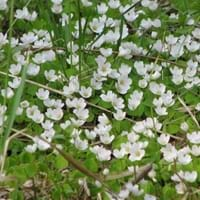Life Span
Annual and Perennial
Perennial
Type
Bulb or Corm or Tuber
Perennial
Origin
Central America, South America
World, Pandemic, North America, Europe, United Kingdom, Asia
Types
Vine, Flowering plant
Not available
Number of Varieties
Not Available
Habitat
All sorts of environments, Along Railroads, Banks, Moist Ditches, Roadsides, rocky banks of streams
Shaded sites, Woodlands
USDA Hardiness Zone
10-13
3-8
Sunset Zone
21,22
A3, 1a, 1b, 2a, 2b, 3a, 3b, 4, 5, 6, 7, 8, 9, 10, 14, 15, 16, 17, 18, 19, 20, 21, 22, 23, 24
Habit
Vining/Climbing
Mat-forming
Minimum Width
Not Available
Flower Color
Purple, Rose
White, Light Pink
Flower Color Modifier
Bicolor
Bicolor
Fruit Color
Not Available
Not Available
Leaf Color in Spring
Purple, Dark Green, Black
Light Green
Leaf Color in Summer
Light Green
Light Green
Leaf Color in Fall
Several shades of Green
Light Green
Leaf Color in Winter
Light Green
Light Green
Leaf Shape
Acicular
Heart-shaped
Plant Season
Spring, Summer, Fall, Winter
Spring, Summer, Fall
Sunlight
Full Sun, Partial Sun
Partial Sun, Partial shade, Full Shade
Growth Rate
Very Fast
Fast
Type of Soil
Clay, Loam, Sand
Clay, Loam, Sand
The pH of Soil
Acidic, Neutral, Alkaline
Neutral
Soil Drainage
Well drained
Average
Bloom Time
Late Spring, Early Summer, Summer, Late Summer, Early Fall, Fall, Late Fall
Spring
Tolerances
Drought
Shade areas
Where to Plant?
Container, Ground
Ground
How to Plant?
Cuttings, Leaf Cutting, Tuber propagation
Divison, Seedlings
Plant Maintenance
Medium
Low
Watering Requirements
Keep the Soil well drained, Needs very little water
Water in the early morning hours
In Summer
Lots of watering
Lots of watering
In Spring
Moderate
Moderate
In Winter
Average Water
Average Water
Soil pH
Acidic, Neutral, Alkaline
Neutral
Soil Type
Clay, Loam, Sand
Clay, Loam, Sand
Soil Drainage Capacity
Well drained
Average
Sun Exposure
Full Sun, Partial Sun
Partial Sun, Partial shade, Full Shade
Pruning
Remove damaged leaves, Remove dead branches, Remove dead leaves
Remove damaged leaves, Remove dead branches, Remove dead flowers, Remove dead leaves
Fertilizers
All-Purpose Liquid Fertilizer
All-Purpose Liquid Fertilizer
Pests and Diseases
Red blotch
Aphids, Root rot, Whiteflies
Plant Tolerance
Drought
Shade areas
Flower Petal Number
Single
Single
Foliage Texture
Coarse
Medium
Foliage Sheen
Matte
Matte
Attracts
Aphids, Beetles, Cutworms, Insects, Mites, Whiteflies
Insects
Allergy
Abdominal pain, allergic reaction, Nausea, Skin rash, Twitching of face
Asthma, Depression
Aesthetic Uses
Not Used For Aesthetic Purpose
Not Used For Aesthetic Purpose
Beauty Benefits
Not Available
Good for skin, Not Available
Environmental Uses
Air purification
Air purification
Medicinal Uses
Cures constipation, Fiber, Low calories, lowering blood pressure, Potassium, ß-carotene, Vitamin A, Vitamin C
Digestive, Eye Problems, Vitamin A, Vitamin C
Part of Plant Used
Leaves, Root, Shoots, Stem, Tuber
Flowers, Leaves
Other Uses
Starch, Used As Food, Used as Ornamental plant
Cleanser
Used As Indoor Plant
Sometimes
No
Used As Outdoor Plant
Yes
Yes
Garden Design
Container, Edible, Groundcover, Hanging Basket, Herb / Vegetable, Mixed Border, Rock Garden / Wall, Vine
Container, Mixed Border, Wildflower
Botanical Name
IPOMOEA batatas 'Blackie'
OXALIS acetosella
Common Name
Blackie Sweet Potato Vine, Sweet Potato Vine
wood sorrel, common wood sorrel
In Hindi
शकरकन्द
Wood Sorrel
In German
Süßkartoffel
Sauerklee
In French
Patate douce
bois Sorrel
In Spanish
Ipomoea batatas
alazán de madera
In Greek
Sweet potato
ξύλο Sorrel
In Portuguese
Batata-doce
Sorrel de madeira
In Polish
Wilec ziemniaczany
Drewno szczaw
In Latin
Ipomoea batatas
Rumex ligno
Phylum
Tracheophyta
Magnoliophyta
Class
Magnoliopsida
Magnoliopsida
Order
Solanales
Oxalidales
Family
Convolvulaceae
Oxalidaceae
Clade
Angiosperms, Asterids, Eudicots
Angiosperms, Eudicots, Rosids
Tribe
Not Available
Not Available
Subfamily
Not Available
Not Available
Number of Species
Not Available
Importance of Sweet Potato Vine and Wood Sorrel
Want to have the most appropriate plant for your garden? You might want to know the importance of Sweet Potato Vine and Wood Sorrel. Basically, these two plants vary in many aspects. Compare Sweet Potato Vine and Wood Sorrel as they differ in many characteristics such as their life, care, benefits, facts, etc. Every gardener must at least have the slightest clue about the plants he wants to plant in his garden. Compare their benefits, which differ in many ways like facts and uses. The medicinal use of Sweet Potato Vine is Cures constipation, Fiber, Low calories, lowering blood pressure, Potassium, ß-carotene, Vitamin A and Vitamin C whereas of Wood Sorrel is Digestive, Eye Problems, Vitamin A and Vitamin C. Sweet Potato Vine has beauty benefits as follows: Not Available while Wood Sorrel has beauty benefits as follows: Not Available.
Compare Facts of Sweet Potato Vine vs Wood Sorrel
How to choose the best garden plant for your garden depending upon its facts? Here garden plant comparison will help you to solve this query. Compare the facts of Sweet Potato Vine vs Wood Sorrel and know which one to choose. As garden plants have benefits and other uses, allergy is also a major drawback of plants for some people. Allergic reactions of Sweet Potato Vine are Abdominal pain, allergic reaction, Nausea, Skin rash and Twitching of face whereas of Wood Sorrel have Asthma and Depression respectively. Having a fruit bearing plant in your garden can be a plus point of your garden. Sweet Potato Vine has no showy fruits and Wood Sorrel has no showy fruits. Also Sweet Potato Vine is not flowering and Wood Sorrel is flowering. You can compare Sweet Potato Vine and Wood Sorrel facts and facts of other plants too.





